Inclusive thinking
We all use streets to get around our town centres, so it’s important that they work well. This section has examples, lessons and sources of further information from around Scotland. It will help you:
- Maximise the impact of physical changes to streets by integrating with initiatives to change people’s behaviours (e.g. Motherwell, Prestwick, Chester, Perth and Kinross)
- Involve people in decision making to prioritise resources for street improvements and help everyone understand each other's perspectives (the Perth and Kinross example focuses on disabled users, but anyone could be involved)
- Make a case to get funding for improvements to streets and public spaces (the Alloa example)
- …and much more besides
Check out also the Resources page for Inclusive Environments.
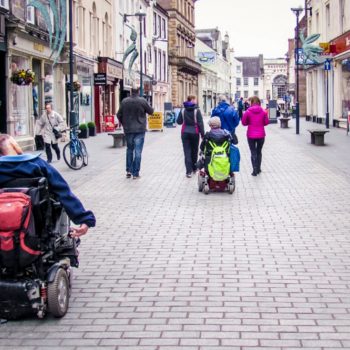
Be dementia-friendly: Motherwell and Prestwick
Motherwell became the first dementia friendly community in Scotland after a collaborative effort involving Alzheimer Scotland, North Lanarkshire Council, NHS Lanarkshire and others.
This detailed case study of the work is effectively a toolkit for any community which wants to become dementia friendly. It explains how Motherwell went about it, with useful lessons for any other town thinking of doing the same thing. Key things to remember are that making a town centre ‘dementia friendly’ involves design of the physical environment, so people can navigate and move around comfortably; and also awareness, so shopkeepers and others know to recognise and support people living with dementia.
In Prestwick, Dementia Friendly Prestwick has been doing a lot of work in the town to make it more inclusive. It’s a local charity, set up by local people, to help people living with dementia and their carers to continue being part of the community and live as individuals. The organisation works to raise awareness, improve infrastructure, and lay on additional services.
Activities include a weekly walk along the promenade, where the chat is as important as the walk for people who are isolated. Paths for All has been providing support to help improve the promenade itself so that it’s more inclusive for everybody in the community.
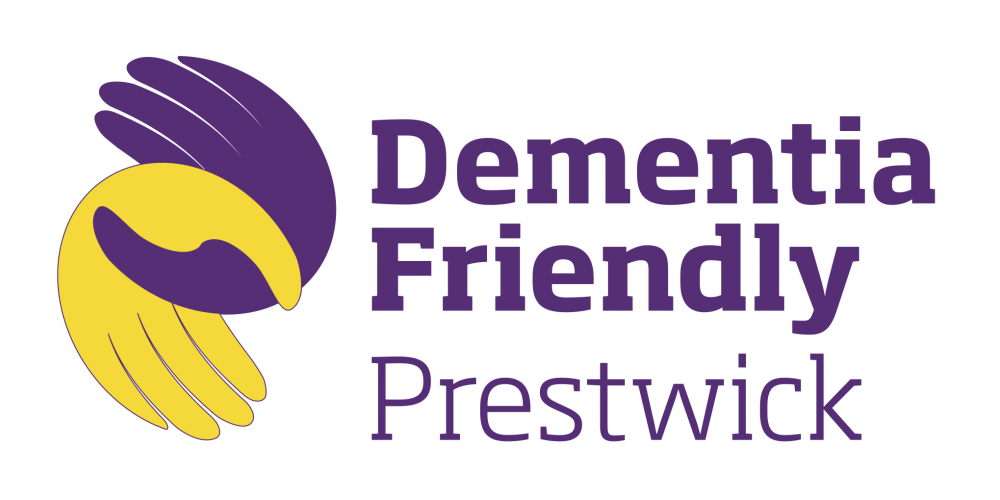
There are no hard and fast rules for making an outdoor space more dementia friendly and accessible, but Paths for All’s dementia-friendly design toolkit and other information on this page are a great starting point. A lot of the design tricks are very simple: for example, clear use of colour, and make seats look like seats! This means that dementia-friendly design is good for lots of people, not just people who live with dementia: young children and families, visually impaired people or anybody with a learning or mobility disability can all benefit.
Further information:
- Alzheimer Scotland offers useful support for setting up dementia friendly communities from their experience across Scotland.
- Paths for All offers a dementia-friendly design toolkit and information on dementia-friendly environments and walking.
- Visit Scotland offers a dementia-friendly tourism guide for businesses as part of their Inclusive Tourism Toolkit.
Involve people in design and maintenance: Perth and Kinross
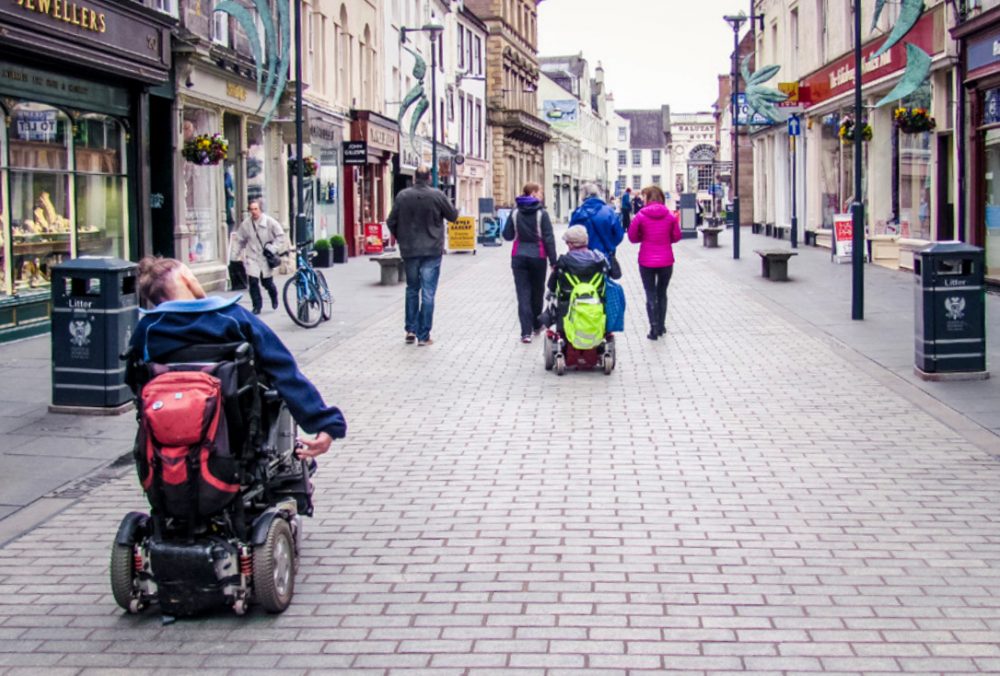
Perth and Kinross Council, Living Streets Scotland and the Centre for Inclusive Living Perth and Kinross (CILPK, a user-led disability organisation) have developed a new approach to designing and managing streets with local involvement – which stemmed from the council needing to prioritise the increasing number of requests it received from disabled people to install dropped kerbs, deal with footway obstacles like street furniture, or make other street improvements.
The council approached Living Streets Scotland (acting as facilitator) and CILPK to develop a programme of Community Street Audits. These are guided walks carried out jointly between transport engineers and disabled people. They identify barriers to disabled people using a route-based approach, rather than seeing problems in isolation, and form the basis of a system for prioritising the use of available budgets. A dedicated budget (initially £10,000) was also allocated for physical works needed as a result of the audits, which took place in Aberfeldy, Blairgowrie, Coupar Angus, Crieff, Kinross and Perth.
The project resulted in a whole range of positive outcomes, extending way beyond improvements to the routes that were audited, including:
- Short-term ‘quick wins’ like new dropped kerbs, tactile strips, relocation of street furniture, and an A-board guidance note.
- Disabled people worked directly with retailers on problem streets to raise awareness of the difficulties that ‘A-boards’ can cause, which led to a more responsible approach by many local shops.
- Training helped professional staff to understand the barriers that disabled people faced, and helped disabled people to understand the practical reasons why streets are designed as they are and constraints that limit scope for change.
- A series of short videos produced by CILPK highlighted particular issues for disabled people, which are useful for anywhere in the country.
- Disabled people became more confident in spotting and reporting problems, without having to resort to media or political pressure.
- Contact with Transport Scotland, who are responsible for the trunk roads that run through a number of local town centres, about safe places to cross these major roads.
The three-way partnership of the local authority, CILPK and Living Streets Scotland was key to success. CILPK was an essential partner as the local organisation for disabled people; and good communications, facilitated by Living Streets Scotland, helped to build trust between the council and disabled people.
Key lessons included:
- Manage expectations honestly: be frank about the scope for change.
- Establish trust and honesty between key individuals in roads authority and disability group(s).
- Involve a wide range of engineering and technical staff: an opportunity to widen professional horizons.
- Adopt a route-based approach: e.g. train station to town centre, access to Post Office.
- Follow up audits with tangible action on the ground.
- Establish a dedicated budget if possible.
- Give feedback to participants: share reports and let them know of successes.
Living Streets also work in other parts of Scotland – see Resources section.
Disability and accessibility: Chester
Chester is famous for its historic city walls and shopping arcades, all of which are fully accessible through ramps, lifts and escalators. Seven Changing Places toilet facilities enable disabled people to visit the city for longer periods. All of the city’s taxis and buses are wheelchair accessible. Ability Angels provide shopping companions. A city centre guide helps disabled people to find their way around. Detailed access information is available online through the Council's website and AccessAble’s website and app.
The council goes way beyond what is required by law to ensure that disabled people can visit and enjoy the city, and traders report that improving accessibility has brought increased numbers of older and disabled visitors to visit and spend in local shops, leisure and heritage facilities. And this is a big market, with high street shops losing an estimated £267m per month by ignoring the needs of disabled people, while 8 out of 10 disabled people say they struggle when holidaying in the UK according to research by Leonard Cheshire Disability.
According to leading disability organisation Purple (see below), disability is an untapped and largely ignored commercial opportunity for businesses – including in town centres. With 25% of our population ageing or disabled, the Purple Pound equates to £249 billion a year to the UK economy. Yet very few businesses have direct strategies to tap into this consumer market, despite the financial and social benefits.
Chester won the First Prize in the EU Accessibility Awards in 2016 for making its historic centre fully accessible, and demonstrating that it makes economic sense to invest in accessibility.
“We’re not a city that has suddenly said: ‘Let’s make this accessible,’” said Graham Garnett, former access officer the local authority and the architect of the Access Award bid. “It has been a commitment over many years.” According to an informative report in The Guardian, Graham says it was this long-term approach that caught the eyes of the European judges rather than any big new developments.
For an international example of what can be achieved, check out how the town of Toyama in Japan has restructured itself since 2007 to respond positively to the challenge of an ageing and declining population. Initiatives included revitalising public transport, creating a network of fully accessible walking routes, relocating public facilities such as clinics and community centres to accessible central locations, and creating a network of frequent small parks where people can meet.
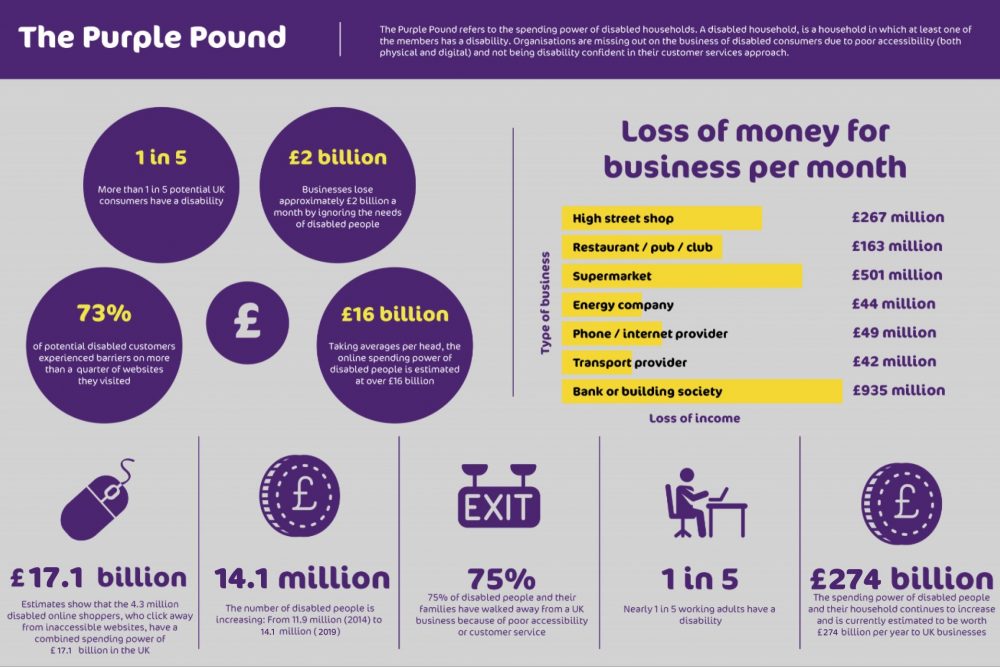
For more information in improving accessibility in town centres, contact Purple: a leading disability organisation offering training, consultancy and access auditing services to help improve disabled people’s experiences.
Purple is the creator of the internationally renowned Purple Tuesday initiative, that calls on organisations to improve the disabled customer experience. Their work in town centres includes this case study in Chelmsford. For more information visit: www.wearepurple.org.uk or contact membership@wearepurple.org.uk
Better town centre neighbourhoods: Queen Street, Dumfries
When thinking about improving town centre neighbourhoods, a vital but often overlooked element in the design process is involving those who live, work and travel through an area right from the start. Walk Wheel Cycle Trust (formerly Sustrans Scotland), through their Street Design programme, worked with Dumfries and Galloway Council’s transport and housing regeneration functions over a five year period to transform a once neglected part of Dumfries town centre into a more liveable, inclusive and active travel friendly neighbourhood - undertaken through a collaborative design process.
“The buildings were generally run down and a lot of people had given up because of vandalism and people stealing their plants in the past, had given up trying to make the place look nice.” (local resident)
Dumfries Neighbourhood Street Design Project centred on an area of Victorian sandstone housing and businesses near the centre of Dumfries. The neighbourhood was effectively a residential ‘island’, isolated by two major roads. The project built on a local regeneration programme by looking at opportunities to improve the physical and social wellbeing of the area. Longstanding concerns over traffic movement and the potential to improve the physical feel, sociability and distinctiveness of the neighbourhood have also been addressed and incorporated into a journey of co-design and co-delivery with the local community.
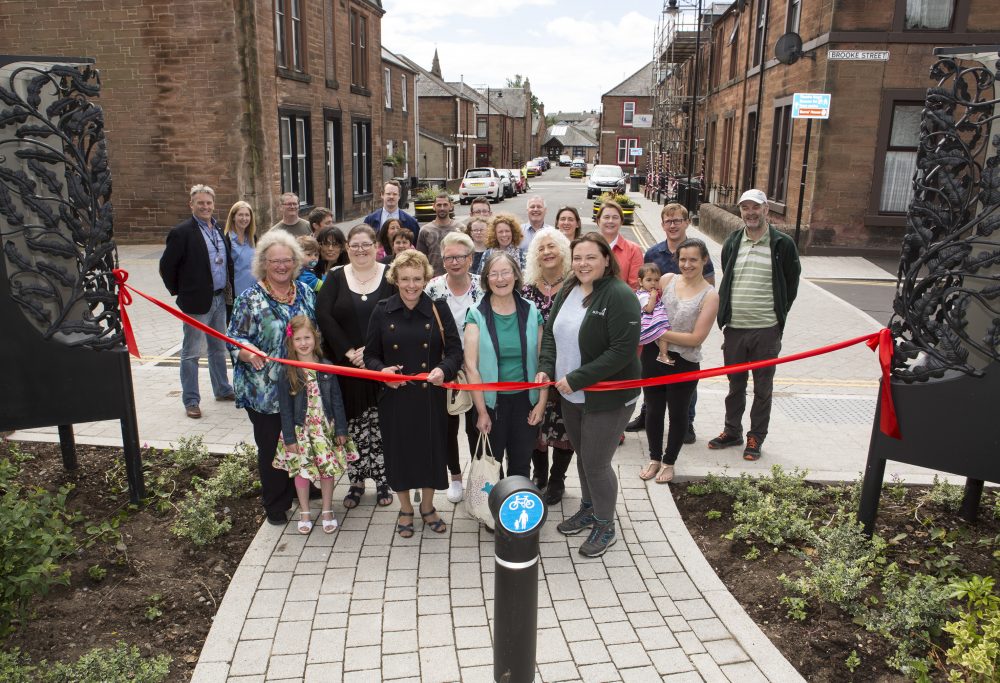
What was the result? What started out as a street design project ended up delivering a lot more:
- An empowered community: residents formed a constituted group during the project and now continue to improve their neighbourhood.
- An accessible neighbourhood: crossing the road is easier and safer for people with reduced mobility.
- A 20mph neighbourhood: walking and cycling is prioritised over vehicle movements.
- A distinctive neighbourhood: lighting, signage and artwork that celebrate the built Victorian heritage of the area.
- A greener neighbourhood: on-street planters, trees and new civic space that calms the area.
From analysis of before-and-after data, there were some big changes as a result:
- 28% reduction in recorded vehicle movements through the neighbourhood.
- 64% increase in how ‘pedestrian friendly’ the neighbourhood is.
- 63% increase in residents agreeing that the neighbourhood has more space to socialise in.
You can find more information about the project on the Walk Wheel Cycle website here and in this brochure together with more information about the Street Design programme.
Collaborative delivery: Alloa
Making use of £0.7m capital funding from the Scottish Government’s Town Centre Fund 2019-20, Clackmannanshire Council and Alloa First BID put the Scottish Government’s Town Centre First Principle and Place Principle into action to make the town centre more accessible. This includes with support from the Scottish Government, Scotland’s Towns Partnership, Scottish Futures Trust, Scottish Enterprise and Architecture and Design Scotland.
The partners were ready to tap into the Town Centre Fund, having gathered technical evidence from a Your Town Audit in 2015 and community/stakeholder evidence through a Place Standard audit in 2019. This evidence led to selection of projects for the Town Centre Fund which were focused on remodelling streets and spaces. The projects included safer pedestrian environments on key town centre streets, plus an active travel hub and new station car parking.
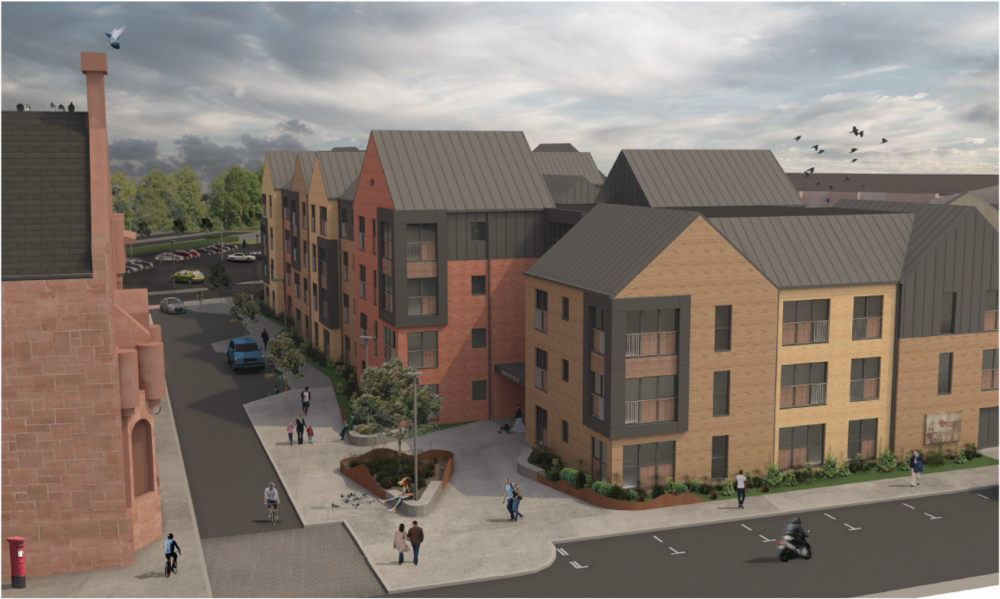
The project helps to improve the quality of pedestrian spaces and accessibility, and the move towards a low carbon town centre. These actions were part of a wider strategy for Alloa town centre which includes:
- New intergenerational dementia-friendly housing in the town centre as the retail footprint shrinks – including a 60-unit development on a large vacant site in the town centre by the local housing association, Health and Social Care Partnership and local authority, which is part of a strategy of enabling older people to downsize and free up their family-sized homes. The new homes put into practice the principles of A Caring Place, a report by Architecture and Design Scotland about how to redesign our town centres for an ageing population where health and wellbeing are central.
- Public art, greenery, events, banners and signage to bring colour to the town centre.
- New town centre website, social media and communications.
Alloa First BID has played a leading role alongside the local authority, acting not only as the voice of private and social enterprise in the town centre, but also delivering a host of projects since it began life in 2008. The Business Improvement District is now into its fourth five-year term, with a new business plan and board providing fresh impetus.